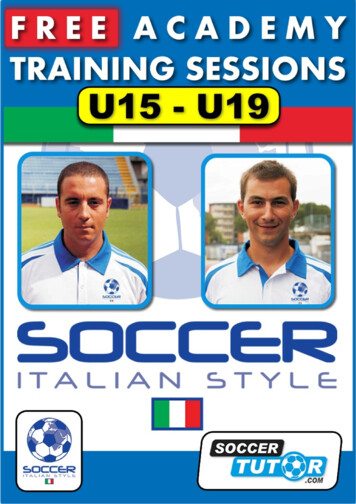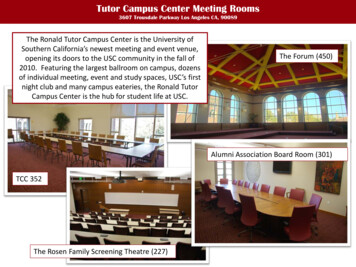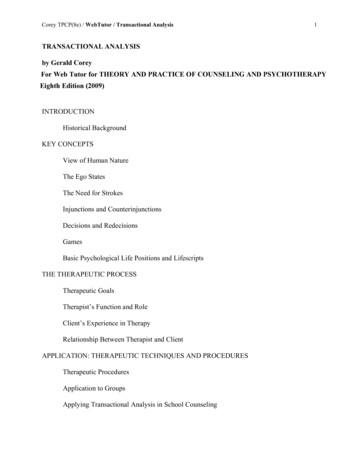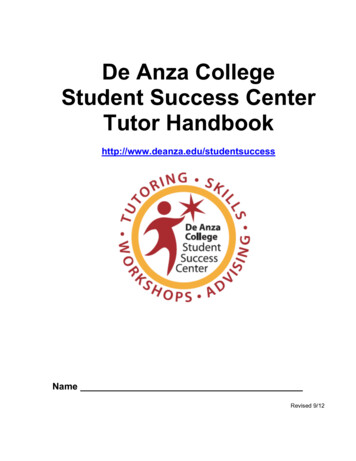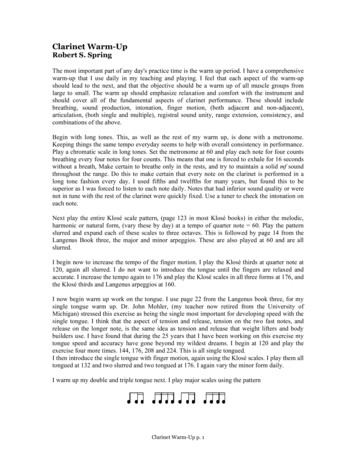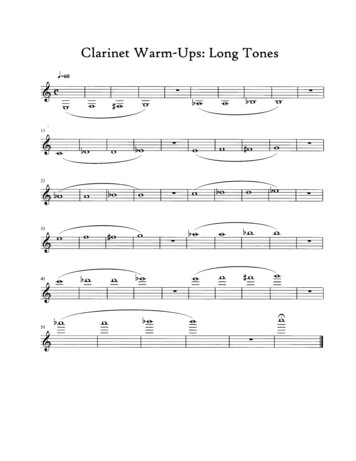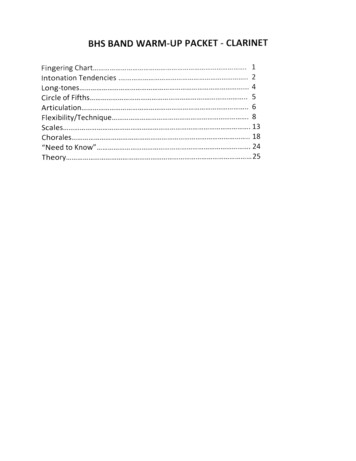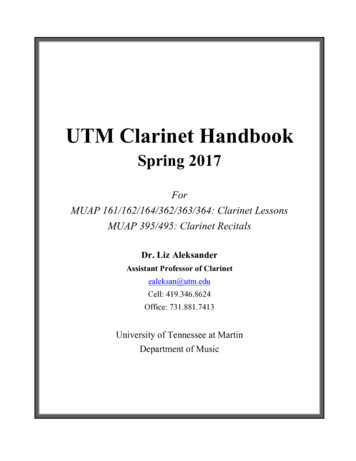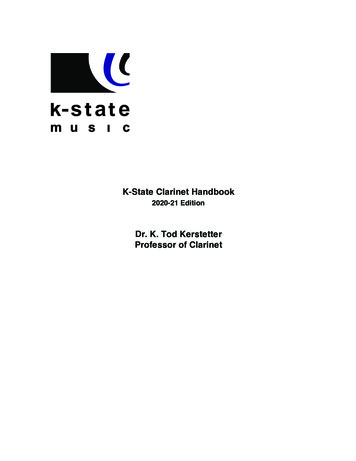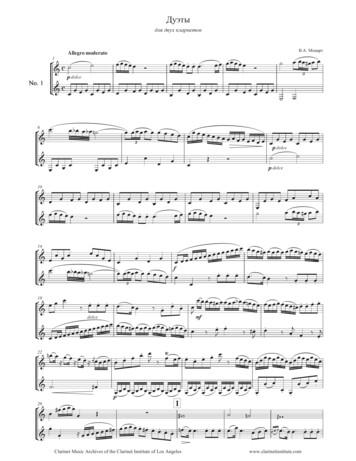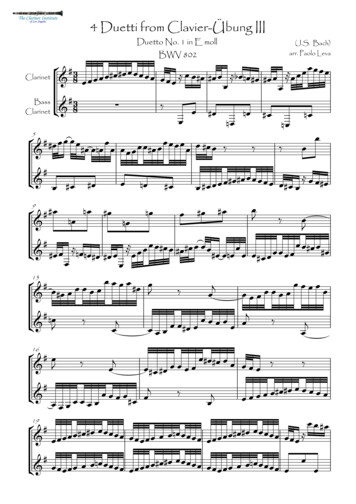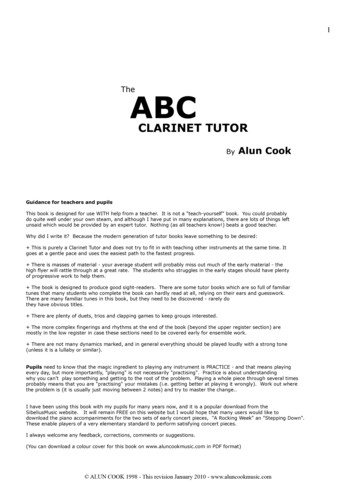
Transcription
1TheABCCLARINET TUTORByAlun CookGuidance for teachers and pupilsThis book is designed for use WITH help from a teacher. It is not a "teach-yourself" book. You could probablydo quite well under your own steam, and although I have put in many explanations, there are lots of things leftunsaid which would be provided by an expert tutor. Nothing (as all teachers know!) beats a good teacher.Why did I write it? Because the modern generation of tutor books leave something to be desired: This is purely a Clarinet Tutor and does not try to fit in with teaching other instruments at the same time. Itgoes at a gentle pace and uses the easiest path to the fastest progress. There is masses of material - your average student will probably miss out much of the early material - thehigh flyer will rattle through at a great rate. The students who struggles in the early stages should have plentyof progressive work to help them. The book is designed to produce good sight-readers. There are some tutor books which are so full of familiartunes that many students who complete the book can hardly read at all, relying on their ears and guesswork.There are many familiar tunes in this book, but they need to be discovered - rarely dothey have obvious titles. There are plenty of duets, trios and clapping games to keep groups interested. The more complex fingerings and rhythms at the end of the book (beyond the upper register section) aremostly in the low register in case these sections need to be covered early for ensemble work. There are not many dynamics marked, and in general everything should be played loudly with a strong tone(unless it is a lullaby or similar).Pupils need to know that the magic ingredient to playing any instrument is PRACTICE - and that means playingevery day, but more importantly, "playing" is not necessarily "practising". Practice is about understandingwhy you can't play something and getting to the root of the problem. Playing a whole piece through several timesprobably means that you are "practising" your mistakes (i.e. getting better at playing it wrongly). Work out wherethe problem is (it is usually just moving between 2 notes) and try to master the change.I have been using this book with my pupils for many years now, and it is a popular download from theSibeliusMusic website. It will remain FREE on this website but I would hope that many users would like todownload the piano accompaniments for the two sets of early concert pieces, "A Rocking Week" an "Stepping Down".These enable players of a very elementary standard to perform satisfying concert pieces.I always welcome any feedback, corrections, comments or suggestions.(You can download a colour cover for this book on www.aluncookmusic.com in PDF format) ALUN COOK 1998 - This revision January 2010 - www.aluncookmusic.com
2EF& wGoodwABoywBDeserveswwFavourwwSEMIBREVE 4 Beats MINIM 2 Beats(half note)CROTCHET 1 Beat(quarter note)QUAVER ½ Beat(eighth note)SEMIQUAVER ¼ Beat(sixteenth note)rœSEMIBREVEor a whole bar restwECAwjœRESTS:FFwwwwETHE NOTES IN THE SPACESœ DwTHE NOTES ON THE LINES&CwwwwEvery& wGÓMINIMŒCROTCHET(whole note)‰QUAVER SEMIQUAVERIt is really useful to understand the piano keyboard. If you are new to this and do not know the note names,look for the "Dog in the Kennel". To explain, the black notes go in a series of 2 then 3 then 2 then 3 etc.Find a group of 2 (that's the "Kennel") and the note in the Kennel is D (for Dog!)
3&EDCwwwœ CROTCHET MINIM 1 beat 2 beatsw SEMIBREVE 4 beats14&4 & 44 & œ œw23& 44& œ œœ œ The curved lines under the notesare called "slurs". They ask youto play the notes smoothly(all in one breath).ww œ œ œ œ w44&4 œ œ œ œ & œ œ œ œœ œ œ œ w œ œ œ œ œ œ w54&4 œ œ œ œœ œ & œ œ œ œ wœ œ œ œwœ œ œ œ
46& 44 œ œ œ œ & œ œ œ œwœ œ œ œ wWhen you have several quavers togetherthey are usually joined with a lineat the top or bottom called a beam.jœ QUAVER worth half a beat - (half a crotchet)& 447&ww j j j jœœœœ œ œ œœœœ œ œ œ œœ œ œ œœœœœœœœœ œœœœ 84&4 œ œ œ œ œ œ œ œ œ œ œœ œ œ 94&4 œ œ œ œ œ œ œœœœœœœœœœœœœœœœ œœœœ 34 . DOTTED MINIM 3 BeatsTAKE YOUR PICK FROM THESE EXPLANATIONS* The dot makes the note 50% longer* The dot increases the length of the note by half its original value* Cut the note in half - add the half on* 2 half of 2 310& 43 . . . .œ NEW TIME SIGNATUREThe top number tells you howmany beats there are in every barThe bottom number tells youwhich type of beats are beingused - i.e. 4 at the bottom meanscount in crotchets œ .113& 4 œ œ œ œ œ œ œ .œ œ œ œ œ œ & œ œ œœ œ œœœ œ œ œ .œ .
5122&4 œ œ œœ œœ œœ œ œ œ œ œ œwœ œ œ œ œ œ œ œwœ œ œ œ œ œ œœ œœ œ œ 134&4 œ œ œ œ 4&4 œ œ œ œ & œœ œ œAlways start your practice by playing without music.Playing tunes by ear is great! Although we have onlylearned 3 notes written down, you will have been shownenough notes to be able to play plenty of tunes by ear:Frere JacquesLondons BurningLondon Bridge is falling downAway in a MangerHappy Birthdayw& œ œ œ œwNEW NOTESCDEwwwFGwwThis "G" is knownas "open G"14& 44œ œ œ œ& œ œ œ œ œ œ 15& 44 œ œ œ œ& œ œ œ œ œ œ œ œ œ œ œ œœ œ œ œœ œ œ œ œ œwœ œ œ œ œ œ œ
6Stepping out16& 44 œ œ œ œ œ œ& œ œ œ œ œ œ17Sliding out&œ œ œ œTurning outœ œ œ œ œ œ œ œ œ œœœœ œœœœ192&4 œ œ œ œ œ œ œ & 42œ œ œœ œ œ œ œ .18& 44œ œ œ œœ œ œœ œ Œœ œ œ œ œ œ œ œ œ œ .& 43 œ œ œ œ& œ œ œœ œ œ œ œ œœ œ œ œ œ œ œ œ œ œ œ œ œ œœœœœ œHarmony!œ œ œ œ œ œ œœ œ œ& œ œ & œœœ œ œ œ œ œ œ œ 204&4 œ œ œ œ œ& œ œ œœœœ œ ŒŒœ œ œ œœœ œ Melodyœ œ œœœ œ œ œœœ œ œ œœœ œœœœ œ œ œ œœœ
7T-T-T-TONGUING21& 44 œ œ & œ œ œ œ œ œ œ œ 22& 44 œ œ & œ œ œ œ 25œ œ œ œœ œ œ œ œ œ œ œœ œ œ œ œ œ œ œ œ œ Œœ œ œ œ .24& œœœ Big Trombone?4&4 œ œ œ œ& 42 œ œ œ œ œ œ œ 23& œ œ œ œ œ œPierpointœœœœ œœœœœœœ œœœœœœœ œœœœ œœœœ œ œœœœœ œœœœ œœœœ Stamping Dance4&4 œ œ œ œ(Stamp in the rests)& Œ œ œŒ œ ŒœŒœ œ œ œŒœ Œ œ œ œ œ œ
8SLURS AND TONGUINGClimbing up the Hill264&4 œ œ œ œ œ œ œ œ œ œ œ œ œ œ & œœœœœœœ œœœ œœœ œœœœœœœ œœœ Mixing it27& 44 œ œœ œ œ œ& œ œ 4&4 Œ œ œ œ & œ Œ œ œŒw œ œ œ& .& œ œœœ œ œ œœ œ œ Œw .œ œ œ œwTraditionalœ œ .Œ ÓKatie's Waltzœ œ œœ œ œ œœ œ œ30& 42Who's coming?œ œ œ œw29& 43œ œ œ œ œ œ w28& œ œ œ œœ œ œ .œ œ œœ œ œ œœ œ œ .œ œ œ œ .Quick Marchœ œ œ œ œœ œ œ œ œ œ& œ œ œ œ œœ œ œœ œ œ œ œœ œœ œ Œœ œœ œ œœœ œ œ œ œ œœ œ œ œ œŒ
& 44 & œ œ 324&4 33& 44 œ œ œ œ œ œ œœœœ & œ œ œ œ œ œ œ œ œ œ34 œ œ œ œ œ œ œ œ œ œœœ œœ Twos into Three3&4 œ œ œ .œ œ œœ œ œ .& œœ œ œœ œ œœ œ . .œ œ œ .œ œ œ œ œ œ œ œ œ . Vitamin 'C'?353&4 œœ&œ œ œ œ œ œœœœ œœœ . SEMIQUAVER worth a quarter of a beat - (half a quaver)36& 42 Smooth Twos Too œ œ œ œ Smooth Twos Twoœ œœœœœ& œ œ œ œœR9Smooth Twos31œœœœœœ œœœ œœœœ œœ& œ œ œœœ œœœœ œ œ œ œ œ œ œR R R Rœœ œœœ œ œ œ œ œ œœœ œœœœœœ œ œ œœœœœœ œ œœœœœ œœ
10372&4œ œ œ œœ œœœœœœœœ œœœœœœ œ& œœœœœ œ œ œœœ œœœœœœœ œœ œ œThin Ice383&4 3&4 œ œ . . œ œ . .œ œ . . œ œ . .& œ œ œ .œ œ œœ œ œ& . œ œ œ .œ œ œœ œ œ . & 43 3&4 & ŒLullaby39&ŒŒœ œ œ . .œ œ œ . œ œ œ . .œ œ œ . œ œ œ œœ œ œ .œ ŒŒ œœ œ œ .œœ œ œœ œ œ40j& 42 œ œ ‰ œ œ œ2& 4 œ œ ‰ œj œ œ¿STAMP Jœ œ œMind Your Feet!jœœ‰ œ œ œ‰ œjœœ œœ‰ j‰ œj œ œœœœ¿ œ œ œœ œ ¿JJŒŒŒœœœœ œ ŒŒœœœœ œ¿J
QUIZ TIME11Can you add the time signature to each of these pieces1&œ œ œ œ œ2&œ œ œ3&œœœœ œ œ œ œ œœœœ œ œ œœœœœœ œ œœ œ œ Œœœ You'll know this piece! Fill in the empty bar (try to work it out in your head - don't try to play it).44&4 œ œ œ œ& œœœœœœœ œ CLAP TRAPS 1œ œ ¿¿ClapTrap 1¿ ¿ ¿ ¿ ¿ ¿ ¿& 42¿Knees(knees)No need for the clarinet for this, but it isbest to sit down. Clap your hands, slapyour knees and use your feet (no needto stamp - just use your heels or toes).Feet¿ ¿ ¿ ¿ ¿ ¿(clap)œœœœœ œœ œ œ œ œ œ¿ ¿ ¿¿ ¿ ¿Trap 2¿ ¿ ¿& 42¿ ¿ ¿(clap)(knees)& ¿ ¿ ¿ ¿Trap 3& 43 ¿¿ ¿& ¿¿& ¿¿¿¿¿¿ ¿ ¿¿ ¿ ¿ ¿¿ ¿¿ ¿(clap)(feet)¿ ¿ ¿ ¿¿ ¿ ¿(feet)¿ ¿ ¿ ¿ ¿ ¿¿¿¿¿¿ ¿ ¿¿ ¿ ¿¿¿¿¿¿¿¿ ¿¿¿¿¿(knees)¿¿¿¿¿¿ ¿¿¿¿¿¿¿ ¿ ¿¿Œ¿Œ
12F#&#w41& 44 nwOld Note(F natural)# # & 44 œ #œ œ œ42& # KEY SIGNATUREG major# 343& 4œ œ œNew Note(F sharp)w œ œ œ œKEY SIGNATURE - If a piece (a tune) is based around a set of noteswhich repeated use the same sharps (or flats) they are placed at thebeginning of each line, to save having to write them in all the time. Thisis called a Key Signature.G major is the name of the KEY which has an F#. The sharp signat the beginning of each line effects every F, no matter how high of low. œ œ .œ œ œ œœœœ œ œ œ .œ œ œ œExtra sharps, naturals (or Flats) added in a piece are known as ACCIDENTALS.Their effect lasts until the end of the bar, but no further.& 44 œ œ #œ œ n œ œ œœ œœ œ #œ& œ #œ œ œ 46All signs continue their effect until theend of the bar.Œ .# 444& 4œ œ œ œ œœ œ œ œœ #Œ& œ œ œ œ œ œ œ œ œ .45The NATURAL sign returns asharpened note back to normal#œ œ œ œ # œ #œ œ œ# #wThe SHARP sign raises the soundof a note by the smallest amountpossible (which is called a semitone).Sharps sound higher than ordinarynotes (naturals). Compare the soundof the old F with the new F#œ œ #œ œ nœ œ& 44 œ œ #œ œ œ nœœ œ #œ n œ œ œ œ œœœœ œ #œ œ œ nœ #œ nœ #œ
ROCK AND ROLLAThis section is very important for your future progress. Developingthe correct hand and finger position is essential if you are to be ableto moving quickly around the instrument.w&47& 44 # 48& 44 # & #œ œ 13You must ROCK and/or ROLL your finger onto the 'A' key withoutlifting it. Listen to see if you are getting an extra note inbetween.The excercises on the next 3 pages will help you to do this! # œ œ # #œ œ œ œ #œ œ œ œ œ #œ œ œŒœ œ œ œ .œ #œ œ œœœœ œSleepy Sarah#4& 4œ œ œ œ œ œ œ œ œ œ#œœœ œœœ œ œ& œœœœ 49#4& 4œ œ œ œ #& œ œœœœœœ œ 50#4& 4œ œ œ œ œ œ # Can I roll my finger?œ œ œœœœ . œ œœœ œœŒI can roll my finger!51 œ œ œœ œ œ œ .Œ#Œ & œ œ œ œ œ .œ œ #Œ œ œ œ œ œ& .œ œ œ wœ œ œ œ œ Œ Ó œ œ
DYNAMICS14pppmpmffpianissimovery quietpianoquietmezzo - pianomoderately quietmezzo -fortemoderately loudffforteloudfortissimovery loud(Literally "half-soft" and "half-loud")Concert PiecesA Rocking WeekA piano accompaniment is available for these5 pieces at www.aluncookmusic.comThis means 2 bars rest.If you are using the pianoaccompaniment, the pianohas 2 bars introduction#2& 452#Manic MondayÛ 2 Û œ œ œ œ œ œ œ œ œFastf#& œœœ œ œ #& œœœœœ œf53SteadyÛ 4& nœ œ œ œœ œ œœ œ œj ‰œ œjœ ‰œj‰œœœœœœ œ œ œœ œ& œœœœœ œ œ œ œ& 42œ œ œ œ œ œœœ œœœœ œ œ œœœ œ œmp Accent (punch the beginning of the note)Spooky TuesdayÛ . œ œ œ œ #œ œ œ œmfœ œ œ œœ œ œ œœ œ œ œ #œ œ œœ œ œ œ œ œ œ œ1.jœ ‰ œ œ œ œœ & #œ œ œ œ nœ œ œ œ œ œ 2.jj& œ œ ‰ œ œ œ œ œ œ ‰ œj ‰ Œ .œj ‰ Œœ
crescendo(getting louder)54Wicked WednesdayStealthily& 44 ppœppœ Û55 Relaxed2& œ & œœœffŒœffœÛfppœ œ #œ œ œ nœ œœ œ œœŒœœœœ œ #œ nœ œ œ œ œ œ mpœœœœ œ œ œ œ .ffœ œ œppffj ‰ Œœœ œ œmpœœœœœ œ œ fœ œ œ œœŒ ŒFiendish Fridayœœœœ œ œ œ #œ œ œ œ œ œ œ œ œ œ œ œ œmf& #œ œ œ œ œ œ œ œ œ œ œ& œ œ œœ œ(wicked bit!)œ œ œ œppœ Therapeutic Thursdayœ œ œ2&4 Û 2 Û56 FastŒppffppœœ œ œ Œ œ Œ œ œff& œ œ œ œ& 43Œ œ Œœ& œ Œ œ Œ& œ15diminuendo(getting softer)œ œ œ œ œ œ œ œ œ œ œ Œœ œ #œœ œ œ œ œ œ œœœ œ œ œ #œ œ œŒ& œ œ œ œ œ œ œ œœ œ œ œ œ œ œœ œ œ œ #œœ
16Going Dotty!57& 43 58& 43œ œœ œœ œ œ œœ œ œ œœ œ œ œœ œ œ œœ œ œ œœ œ œ œœ œ œ œœ œ œ œjœ œjœ œ59& 43 œ60& 43 .œ61œ.œ.jœ œœ.jœ œ3& 4 œ œ œ. œj œ œ œ. œj œ œ œ. œj j& 44 œ. œ & œ.jœ jœ. œ œ œ œ.jœ œ œ .œ œ œ œ .jœ œœ‰ .THE GOLDEN RULEAlways count 3 on adotted note.It may be 3 quavers or3 crotchets, but it willalways be divisible by 3.j œ. jœœ .œ.jœ .œŒŒjœ .Earl of Oxford's March& 44 . œj œœœ .& œ.œ œ œDaily Bread63& œ œ œœ .jœ œ œ. œ .TAKE YOUR PICK FROM THESE EXPLANATIONS* The dot makes the note 50% longer* The dot increases the length of the note by half its original value* Cut the note in half - add the half on* 2 half of 2 362œœ.œœ. DOTTED CROTCHET 3 Quaver Beats (one and a half crotchets) William Byrd (1543 - 1623)Œj .œ. œ œ œŒjœjœœœœ. œ œ œ.Œjœ. œ œ œ .Œj .œ. œ œ œjœ œœœœ œ œ œ ŒœŒ
MORE DOTTED RHYTHMS64& 44 œ. œj œ œLazy Dots j3œ.&4 œœœ œœ œ65& œ œ œ662& 4 œ. œ œjœ œ œœœ.œ œ67 Moderatoœ. œ œœ. œ œ. œ œ Œœ. œ œœœ œœœ œœ œ œœœjœ œ. œœ. œ œœ. œ œ œ œ œœ. œ œ œ œ œ œ ŒThoroughly Dotty .œjœ. œ œ. œj œ. œ œ. œ œ Œj& œ. œ œ. œj œ. œ œ. œ œ Œ& jœ.œœœ œœ œœ œ. œj œ œ œPolka Dotsœ œ œ œ. œ œ. œ œœ ŒWaltzing Dots& œ. œ œ œ œ œ œ Œ4& 4 . jœœœœ.œ œ œ œ œ œ .Steady& œ Œ .jœ œ. œ œ œ œ .j& œ. œ œjœ. œ œ œjœ. œ œ œ& œ. œj œ œ17 .j Œ.œœ.œœœœ. œ œ œœ. œj œ. œj œ. j œ œœœ. œ œ. œ œ œœ .œjœœ. œ. œ œ. œ .Œ
Clap Traps 218¿/¿FingerClick¿HandClapKneesFast/ 44 ¿ ¿ ¿ ¿ ¿/ 44 Feet ¿ ¿ ¿ ¿ ¿ ¿¿ ¿ ¿ ¿ ¿ j¿ ¿ ¿ ‰ ¿ ¿ Ó /¿/ Œ ¿ ¿ Œ j¿ ¿ ¿ ‰ ¿ ¿ ¿ ¿ ¿ ¿ ¿ ¿ ¿ ŒÓjjŒ ¿ ¿ ¿ ¿ ¿ ‰ ¿ ¿ ‰ ¿ ¿ ¿ Œ‰ jŒ¿ ¿ ¿ÓŒ¿¿¿ ¿ ¿ Œ¿¿¿¿¿¿¿¿¿¿¿¿¿¿¿ ¿¿ ¿¿ ¿ Œ . ¿¿¿¿¿ Œ./ .¿¿¿¿¿¿¿¿¿¿¿¿¿¿¿¿¿¿ ¿¿ ¿¿ ¿ Œ . Ó¿¿¿¿./ .¿¿¿¿¿¿jŒ Œ ¿ ¿ Œ ¿¿ ¿ ¿ ¿ ¿ ¿ ¿ ‰ ¿ ¿ ¿¿¿¿ ¿ ¿ŒŒŒŒŒŒŒ ¿ Œ¿ ¿ ¿ ¿ ¿¿¿¿/ ¿ ¿ ¿ ¿ ¿Œ/ ¿/ Œ¿ŒŒ ¿ ¿ ‰ ¿j ¿/ ¿ Œ ¿ Œ¿Œ¿¿¿ ¿¿ ¿¿¿¿ ¿¿ ¿¿¿¿ ¿¿ ¿¿¿¿ ¿¿ ¿¿¿¿ ¿¿ ¿¿ ¿ ¿ ¿¿ ¿ ¿ ¿ ¿ ¿ ¿ ¿ ‰ ¿ ¿Œ Ó/ ¿ ‰ J ‰ J ‰ J ‰ J ‰ J ‰ J ‰ JJ¿j¿ ¿ ¿¿ ¿ ¿ ¿‰Œ Ó¿¿¿¿¿¿/ ¿¿
19B&Stepping Down - Middle and OffA piano accompaniment is available for this piece aspart of set of 12 concert pieces which help you to use theright hand fingers and work your way down the instrument,Available from www.aluncookmusic.comw68Middle and Off& 44œ œ œ œ œ œœ œ œ œ œ& œ œ œ œ œœ œ œ œ œœ œ œ œ œ&œ œ œ œ œœ œ œ œ œ œfœ œ œ œ œ œŒŒœ œ œ œ œ œ& œ œ œ œ œ œ œ œ œ œ œœœ œ œ œ œ œ694&4 œ œ œ œ œ œ œ œ œ œ œ œ œ œ œ ŒŒœ œ œ œœœ œ œ œ œ Œœ œ œ œ œ œ œ œ œ œ œ œ œ œ & œ œ œ œœ œ œ œœ .œ œ œ œ œ œœ œ œ œ œ œ ŒStepping Down - Tiddle-iddle-umA piano accompaniment is available for this piece aspart of set of 12 concert pieces which help you to use theright hand fingers and work your way down the instrument,Available from www.aluncookmusic.com70Tiddle-iddle-umj ‰& 44 œ œœœœœœfj ‰œ œœœœœœœ œœœœœœ œ& œ œ œ œœ œ œ
This is purely a Clarinet Tutor and does not try to fit in with teaching other instruments at the same time. It goes at a gentle pace and uses the easiest path to the fastest progress. There is masses of material - your average student will probably miss out much of the early material - the high flyer will rattle through at a great rate. The students who struggles in the early stages .

